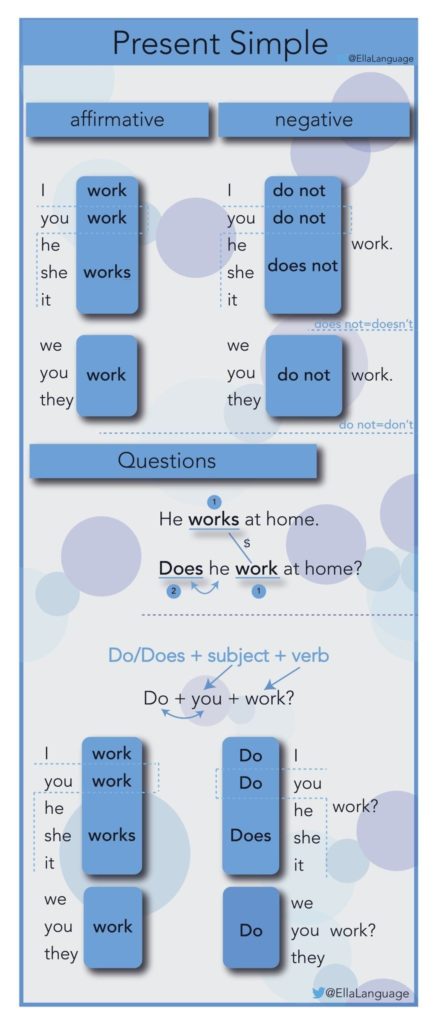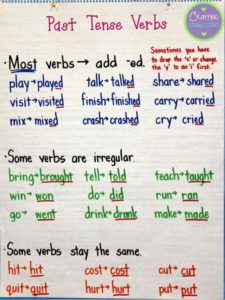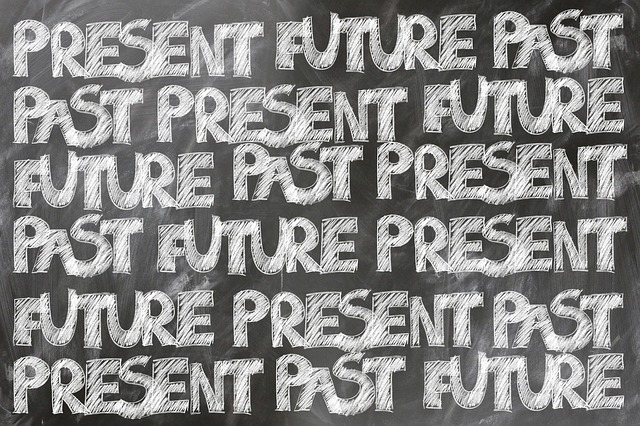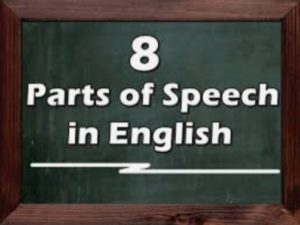Writing is many things and serves many purposes, but with any writing, it is important to know when the reading is taking place. This is where English tenses come into play. In this article, the complex rules of this part of the English language will be discussed thoroughly and will surely answer any questions that you may have on the topic.
English Tenses
Let’s think back for a moment to verbs. Those are the words that are used to describe an action. It also designs the main part of the predicate of a sentence structure. Well, verbs also serve another purpose, depending on the tense of the verb, it will let the reader know when something happened in the sentence or the story.
In the English language, there are three main verb tenses which break down into nine more tense types. English tenses are very important in the English language and are necessary so the reader will know the time period in which an event is happening. The three main English tenses are:
- Present Tense
- Past Tense
- Future Tense
Present Tense
Present tense (e.g. he goes, we see, she listens, I work), also commonly known as a simple present or either present simple amongst the English tenses, is a verb tense that can be used in a number of ways using the subject + main verb combination. Let’s take a look:
- One way this verb tense is used is by describing events that are real-time taking place or is true in general for example, “I like the new cheesecake” or is always a certain way like in the example, “He is six feet, three inches tall and still growing.” As you can see in the first example, I, is the subject and like is the verb which describes a true statement. In the second example, He is the subject and is, is the verb also describing something that is new and a current situation. Both examples follow the subject + main verb combination.
- The second way this verb tense is used is by explaining or describing something that happens often or on a regular basis, such as habits or certain routines. Some common adverbs that are used for present tense are: sometimes, often, frequently, always, usually, and never. Examples of this are: “He usually goes to work every night at 10 pm.” Or, “The mail always arrives at 3 pm every day.”
In the first example, He is the subject followed by the adverb usually and then by the verb goes. This sentence describes a habit that happens often while still following the subject + main verb rule. In the second sentence, the mail is the subject followed by the adverb always and the verb arrives. Again, this sentence follows the subject + main verb rule and describes something that happens often.
- The last way this verb tense is used is by speaking of scheduled future situations that will happen or is happening, transportation being a common one for example: “The plane lands in Philly at 9 pm.” This tense form is also used to describe an action that will happen later for example: “I’ll call the post office when I get home.” As you can see, each example follows the subject + main verb combination.
Simple Present: Negative Sentences
As you can already see, English tenses are very important in the English language and with that said, understanding how to make a negative sentence in the simple present is as equally important. The negative sentence pattern is as follows: Subject + Doesn’t/Don’t + Main Verb In Base Form. Base form meaning the root, or in simpler terms, the dictionary version before any endings are applied such as –s, -ed, -ly, and -ing.
Example 1:
- The artist paints beautiful pictures.
- The artist doesn’t paint beautiful pictures.
Example 2:
- My co-workers like the new manager.
- My co-workers don’t like the new manager.
In example one, you see the sentence is positive and in example two, the sentence is now in a negative form and follows the negative sentence pattern. Subject ( The artist) +(Doesn’t) +Main Verb (Paint) which is in base form unlike paints in example one.
Example two shows the same, the sentence is in a positive form while the second sentence is in a negative form. The second sentence also uses the negative sentence pattern with the exception of, doesn’t is replaced by don’t in the second sentence.
Simple Present: Questions
When making questions in simple present, the sentence structure should be: Do/Does + Subject + Main Verb In Base Form. When asking a question do or does should always come first. Let’s look at some examples:
- You like to read.
- Do you like to read?
- He lives in Cincinnati.
- Does he live in Cincinnati?
Present Perfect
This tense brings attention to an action or state that took place at an undetermined time in the past, for example, we have dated before. This tense also refers to an action or state that began in the past and continued to current time for example, her health has improved over the last couple of days.
To form this tense the formula Have/Has + The Past Participle is used. The subject will determine if the verb have or has will be used, meaning, if the subject is a plural noun, the root verb have, which is typically present tense will normally be used in conjunction with the plural pronouns (you, we, they). If the subject is a singular noun, the root verb has will normally be used in conjunction with the single pronouns (she, he, it, who).
As with anything in the English language, there are exceptions. Although the pronouns I and You, for example, are singular, they are used in conjunction with the root verb have. This is due to the person, meaning, have is used with first and second person singular (I, you, me, my, mine, your, yours) and the third person plural (they, them, their, theirs). Has, on the other hand, is used with third person singular (he, she, it).
The second part of the formula is the past participle which is formed by adding -ed or -d to the base verb. This is shown in the above examples for the past participle verbs dated in the first example and improved in the second example.
The golden rule about the present perfect tense is that, if you are speaking of a specific time of an event happening, you can’t use it. For example,
- I have put away most of the dishes. ✔
- I have put away most of the dishes this afternoon.❌
Present Continuous
This verb tense, also known as a present progressive among the English tenses shows that an action or event is currently happening, frequently happens, and may continue to happen in the future. The formula used to construct this verb tense is To Be (Am, Is, Are) + Verb (Present Participle). For example,
- Mom is warming up the car while the snow continues to fall.
- The are waiting patiently while the results come in.
- I am eating a healthy lunch for once.
This verb tense can also convey an event after it happened, for example, she waited at the stop sign thinking it was a red light. It can also be used to convey to the reader the urgency or to add a bit of flare to the sentence when used with a dynamic verb, or in simpler terms, a verb that indicates an action or a process, for example, He is smiling too long, or, She is coughing uncontrollably.
Do not use present continuous tense with verbs that express a state or a condition to change, more commonly known as stative verbs. This type of verb usually refers to emotions, thoughts, relationships, measurements, states of being, possessions, or senses. For example, Sally feels left out. She has no friends at the party. Let’s take a look at a few examples of how not to use this tense.
- Jack is appearing to enjoy the chocolate cake over the strawberry cake. ❌
- Jack appears to enjoy the chocolate cake over the strawberry cake. ✔

Again, there are always exceptions to the rules and the same goes for dynamic and stative verbs. Believe it or not, some verbs can be both! Let’s use the common verb to be for example. While in its dynamic form, this verb shows action, for example, she is being disorderly for no apparent reason.
Yet, in its stative form, the verb to be, if used in present continuous is not grammatically correct. For example, she is being a short woman that adores high cabinets. The correct sentence structure should be, she is a short woman that adores high cabinets.
Present Perfect Continuous
This verb tense, also known as present perfect progressive among the English tenses refers to events or actions that started in the past but has continued in current time. Usually, this verb tense indicates the length of time an event or action has been taking place. Examples are, for three weeks, for two hours, since yesterday. Let’s take a look.
- They have been yelling for the last hour.
- He has been employed for five years with the same company.
- Why has Cindy not been going to physical therapy for the last two weeks?
The formula used to construct this verb tense is HAS/HAVE +BEEN+PRESENT PARTICIPLE as seen in the examples above. Questions can also be created by inserting a subject + has/have while negative sentences can also be created in this tense by adding not. Let’s take a look at some examples.
- She has been single for two years. (Statement)
- Has she been single for two years? (Question)
- She has not been single for two years. (Negative)
The words “lately” and “recently” can be used with this verb tense instead of a specific duration such as “since yesterday” to give a more general meaning, for example,
- Have you been keeping up with the news lately?
- Recently, I have been feeling light headed.
- He has been drinking more water than usual lately.
Present perfect continuous tense can also be suggestive if used in a question so one should be very careful to use the tense correctly to not unintentionally offend anyone. More simply put, this tense in question form usually infers that you can smell, hear, see, or feel the suggested action which can sometimes be taken the wrong way. For example,
- Have you been eating? (This question may suggest that the person in question looks unhealthy)
- Have you been washing everyday? (This question may suggest that the person in question may smell)
- Have you been listening the announcements? (This question my suggest that the person in question is missing some information or not hearing something in detail)
Remember
Do not use stative or non-continuous verbs in the continuous tense.

Past Tense
Past tense (e.g. I played, She cooked, He wanted, They went, He worked) also commonly known as simple past, is used to refer to something that has already happened. The ending –ed is added to the verb tense’s regular version to create its past version as shown above. With that said, there is one very common exception to the rule when it comes to the very popular verb “To Be” which consists of two different forms in the English language, was and were.
Irregular Verbs
Irregular verbs in the English tenses and English language, simply put, are verbs that disobey the rule of adding -d or -ed at the end of the base verb to indicate its past tense status. The English language consists of nearly 200 of these tricky little verbs so be aware!
Past Tense: Negative Sentences
Just like simple present, simple past tense has its own specific negative sentence structure which is: SUBJECT + DIDN’T (DID NOT) + MAIN VERB IN BASE FORM. Let’s look at some examples:
- Present: They don’t live together.
- Past: They didn’t live together.
As you can see in the above example, the main verb live is in root or base form. Also, the auxiliary verb didn’t in the second example makes the reader aware that the situation is negative and is in the past tense.
Past Perfect
Also known as pluperfect, the past perfect tense among the English tenses is a verb tense that refers to actions that were completed before a specific point in the past but before something else happened. Regardless of if the subject is singular or plural, the formula for past perfect tense is always HAD + (PAST PARTICIPLE). Let’s take a look at an example of this tense:
- It was disappointing that someone had spilled the soup and not cleaned it up.
This example follows the past perfect tense formula and as you also see in the example, the soup was spilled at some point in the past, before someone noticed that it had not been cleaned up. This tense can also be used expressing a condition, or the “if” and a result. For example:
- If I had walked in the kitchen earlier, I would have caught the person red-handed.
As you see in the example, the if clause is the condition; whereas the result would be catching the person red-handed.
When Not To Use Past Perfect Tense
If you are not intending on conveying a sequence of events, then this is not the correct tense to use. If you were asked what you did when you walked in the kitchen and saw the spilled soup, your answer should not simply be, “I had cleaned it up”, it would not make sense for past perfect, this tense requires detail.
Negatives and Questions
To make a negative clause in the past present tense, all you need to do is add not between had and the past participle. Let’s take a look,
- I looked for the culprit with the soup for a few minutes but had not seen anyone fitting the description.
For questions in past perfect, the formula is as followed, HAD + SUBJECT + PAST PARTICIPLE, let’s take a look,
- Had the culprit walked away without realizing the mess they made?
Past Continuous
Also known as a past progressive among the English tenses, the past continuous tense cites a continuing action or state that was in process at some point in the past. The formula in which this tense is formed is WAS/WERE + VERB’S PRESENT PARTICIPLE (i.e. -ing), let’s look at a few examples:
- The moon was shining everyday last week
- As I ate, the people were looking at what I had from the menu.
- The factory was closing early everyday last week.
As you can see in the examples above, each obeys the formula of the past continuous tense. Each sentence lays out in detail events that happened and was happening in the past.
Just like any part of the English language, English tenses can serve many purposes as you may already have noticed and the past continuous tense is no different. This tense can also show an action, state, or event that happened at an exact time in the past or a perpetual action that happened in the past. Let’s take a look:
- Exact or Percise Action: At noon today, I was sleeping soundly.
- Exact or Percise Action: Yesterday at 3 pm, they were taking me to the seminar.
- Perpetual or Habitual Action: He was jumping non-stop again last week during gym.
- Perpetual or Habitual Action: She was counting on her fingers as usual last week during the math exam.
Important Rule of Thumb
Not all verbs can be used in the continuous tense as we have discussed a bit earlier, so be cautious when writing in the past continuous. Take for example the popular verb like in the below sentences,
- At noon she was liking the weather better.❌
- At noon she liked the weather better. ✔
Past Perfect Continuous
Also known as a past perfect progressive among the English tenses, the past perfect continuous tense describes an event or action that started in the past, proceeded into another time in the past and ended at another time in the past. Unlike the present perfect continuous tense that refers to an action that began in the past and continued into the present.
This tense is formed with the formula HAD BEEN + THE VERB’S PRESENT PARTICIPLE. Some common words that may be used alongside the past perfect continuous tense is; when, for, since, and before. Let’s take a look at a few examples:
- I had been waiting for two hours before the announcement was made about the delay.
- He had been running for weeks before he found out he had a small bone fracture.
- She had been watching television for an hour when her brother came in and turned the channel.
As you can see from the examples, this tense is used to refer to a duration in time that an event or action began, then continued in the past and is completed before something else in the past happens. Example one suggest that I had been waiting (past action) for two hours (duration of past action that is continuing) before the announcement was made of the delay (an action that was also completed in the past).
Negatives and Questions
A negative in the past perfect continuous tense is made simply by adding the word not between had and been. For questions in this tense, they are shown by adding had before the subject or hadn’t for a question in negative form. Let’s look at the below examples of each:
- Statement: She had been eating for over an hour when the rest of the family arrived.
- Negative: She had not been eating for over an hour when the rest of the family arrived.
- Question: Had she been eating for over an hour when the rest of the family arrived?
Wh Words
Some sentences may require more detail or information when answered, this is where the “Wh” words will come into play when forming a question in the past perfect continuous tense. Some of the common wh-words are, where, what, when, who, which, why, how, how much, how many.
To form this type of question the formula WH-WORD + HAD + SUBJECT + BEEN + PRESENT PARTICIPLE (root verb + -ing) + REST OF SENTENCE will be used. Let’s take a look,
- What had you been doing when the power was shut off?
- Which letter had you been trying to mail before the mailman left?
- How long had she been watching us?
Important Rule of Thumb
Not all verbs can be used in the continuous tense as we have discussed a bit earlier, so be cautious when writing in the past perfect continuous tense. Take for example the popular non-continuous verb belong in the below sentences,
- She had been belonging to the club for years. ❌
- She had belonged to the club for years. ✔

Future Tense
Future tense or also commonly known as simple future tense among the English tenses is a verb tense used to express or speak about events that have not happened. Simply put, simple future tense should be used when the writer or the person giving the story wishes to talk about something that will start and end in the future. For example,
- Tomorrow morning, the teacher will give out samples of the end of year exam.
The formula used to form this verb tense is WILL + ROOT FORM OF VERB as shown in the example above. But wait a minute… there are always surprises in the English language! This verb tense has yet another formula to show events happening in the future. AM/IS/ARE + GOING TO + ROOT FORM OF VERB, for example:
- I am going to buy a new car.
- My sisters are going to try out for soccer.
- He is going to finish his salad.
Negatives in Simple Future Tense
Negative sentences in the simple future tense are made by the formula WILL + NOT + ROOT FORM OF VERB, for example:
- I will not stop until I am finished.
- Do not be late tomorrow because the group will not wait for you.
- She will not see you if you park over there.
“Going To” in Simple Future Tense
If you prefer to make a sentence structure using the second formula “going to”, then you must use the formula AM/IS/ARE + NOT + GOING TO + ROOT FORM OF VERB to make a negative sentence with this form. Let’s take a look at a few examples:
- I am not going to stop until I am finished.
- Don’t be late tomorrow because the group is not going to wait for you.
- She is not going to see you if you park over there.
Questions in Simple Future Tense
To form a question in this verb tense, the formula WILL + SUBJECT + ROOT FORM OF VERB should be used. Let’s take a look at some examples:
- Will I do enough to stay in the competition?
- What will she eat on her new diet?
- Will the teacher keep the same test from last year?
“Going To” Questions in Simple Future Tense
When using the “going to” phrase to form a question use the formula AM/IS/ARE + SUBJECT + GOING TO + ROOT FORM OF VERB. Let’s take a look:
- Am I going to do enough to stay in the competition?
- What is she going to eat on her new diet?
- Is the teacher going to keep the same test from last year?
Future Perfect
This verb tense should be used to express events or actions that will be finished before another time period in the future. The formula to form this tense is WILL HAVE + PAST PARTICIPLE. Pretty easy right? Also, with the future perfect tense, it does not matter if the subject is singular or plural. Let’s take a look at an example:
- The show will have ended before Susan arrives. The show will be over by the time she will arrive at exit 10.
Here we see the show will be finished by the time Susan arrives to exit 10, which will be at another point in the future.
Future Perfect Tense and Simple Future Tense Interchangeably
In some cases, these two tenses can be used together. Let’s take a closer look at the previous example:
“The show will have ended before Susan arrives.” (In the first section of the clause, the future perfect tense is used which is indicated by the formula will have plus the past participle ended.) But in the second part of the clause, “The show will be over by the time she will arrive at exit 10,” simple future tense is used which is indicated by the formula will plus root verb arrive.
Although both clauses are essentially saying the same thing, these two tenses can be used interchangeably because the preposition by the time makes the sequence of events absolutely clear. We know for sure that the show will end by the time Susan arrives to exit 10.
Before, already, at, when, as soon as, by this time, and from now are other common prepositional phrases that make clear of the sequence of events of a sentence, and without such propositions to make the transition clear, you must use future perfect tense to show what took place first. For example:
- At 9:30 the show will have ended. Susan will arrive at exit 10 at 9:45.
In this example, we know clearly what happens first by the indication of a specific time. At 9:30 the show will end and at 9:45 Susan will arrive at exit 10. Fifteen minutes too late.
When To Simple Future Tense Instead of Future Perfect Tense
The future perfect tense is only used to refer to events or actions that will be finished before a specific time frame in the future. Simply put, these actions have to have an endpoint (e.g. next week, yesterday, two weeks ago, 3 am, after dinner) and if no endpoint is referenced, simple future tense should be used instead of the future perfect tense.
- Simple Future Tense: “Susan will arrive.“ ✔(This tense must be used instead because no deadline is mentioned.)
- Future Perfect Tense: “Susan will have arrived.“ ❌(This tense can’t be used because no deadline is mentioned.)
Negatives in Future Perfect
Negative sentences in this tense are constructed by simply inserting the word, not between will and have, or, even though it may not sound grammatically correct, you can instead use, won’t which is the contraction of will not. Let’s look at some examples:
- His sister will not have defended him before getting all the facts.
- They will not have finished eating before the desert comes.
- The patient won’t have talked to the doctor before filling out the paperwork.
Questions in Future Perfect
Questions in this tense follow the formula WILL + SUBJECT + HAVE + PAST PARTICIPLE, let’s take a look:
- Will his sister have defended him before getting all the facts?
- Will they have eaten before the desert comes?
- Will the patient have talked to the doctor before filling out the paperwork?
Future Continuous Tense
Commonly known as future progressive tense among the English tenses, the future continuous tense shows an action or an event that will happen in the future at some point and continue for a presumed period of time.
To form this tense the formula WILL + BE + PRESENT PARTICIPLE (ROOT VERB + -ING) will be used. Simply put, if an event is expected to happen and be on-going in the future or for a continued duration of time, then the future continuous tense should be used. For example:
- Tomorrow afternoon, I will be learning how to swim in my friends pool.
- I will be sending my mail first class going forward.
- Henry will be experiencing new things at the new pre-school.
Action Verbs Only
The future continuous tense is all about duration. An action happening for a certain or continuing time in the future. Therefore; it would only make sense that only action verbs would be used in this tense.
Why? Because only actions such as hiking, swimming, thinking, writing, and running can be done in duration. Whereas; stative verbs, for example, refers to a state of being such as emotions and thoughts. With that said, these type of verbs, as previously discussed, cannot be used in the continuous tense, one, because that is the rule and two, it would not make sense grammatically. Let’s take a look:
- I will be being listening all day. ❌
- I will listen all day. ✔
- Sally will be knowing all the answers. ❌
- Sally will know all the answers. ✔
- She will be appearing like she is asleep. ❌
- She will appear like she is asleep. ✔
As you can see in the above examples, the stative verbs in bold do not work with the future continuous tense formula WILL + BE + PRESENT PARTICIPLE. Instead, these verbs will only work grammatically with the simple future tense construction WILL + ROOT FORM OF VERB.
Negatives in Future Continuous Tense
Negatives in this tense are simply made by placing not between will and be. For example:
- She will not be attending that event again.
Questions in Future Continuous Tense
Questions in this tense are constructed by placing Will/Shall before the subject. For example:
- Will she be attending that event again?
- Shall she be attending that event again?
Future Perfect Continuous
Also commonly known as the future perfect progressive among the English tenses, this verb tense refers to actions or events that will be on-going until a specific time in the future. This tense is formed by using the formula WILL + HAVE + BEEN + PRESENT PARTICIPLE OF VERB (VERB ROOT + -ING)
Simply put, in the future perfect continuous tense, the action or event will begin in either the past, present, or in the future and the expectation is that the action will continue into the future. Let’s take a look at a few examples:
- In five minutes, I will have been waiting on my Uber for over twenty minutes.
- In May, I will have been going to the same gym for seven years.
- Tomorrow she will have been job hunting for nearly three weeks.
Non-Action Verbs and Future Perfect Continuous Tense
Remember, non-action or stative verbs should not be used in the continuous tense, instead these verb types that describe emotions, thoughts, and states of being (e.g. to be, to know, to appear, to realize) should be n the future perfect tense. Grammatically, non-action verbs would not correct in the continuous form. For example:
- Today I will have been knowing the group for two years. ❌
- Today I will have known the group for two years. ✔
- In two hours he will have been appearing lost since he haven’t found the correct address as of yet. ❌
- In two hours he will have appeared lost since he haven’t found the correct address as of yet. ✔
As you can see, the first sentences in each example are in the future perfect continuous tense and are incorrect. Whereas; the second sentence in each example containing the non-action verbs are in the future perfect tense and is correct.
Negatives in Future Continuous Tense
Negative sentences in this tense can be formed by simply placing not or the contraction won’t after will. The formula will look like this, SUBJECT + WILL/WON’T + NOT + HAVE + BEEN + PRESENT PARTICIPLE (ROOT VERB + -ING).
Also, know that other contractions can be used for singular pronouns (e.g. I / I’ll, You / You’ll, He / He’ll, She / She’ll, It / It’ll) or plural pronouns (e.g. You / You’ll, They / They’ll, We / We’ll). Let’s take a look at a few negative sentence examples:
- At two o’clock they’ll not have been waiting for over an hour.
- He will not have been reading long enough to know the ending to the book.
- She won’t have been skating good enough to skate professionally by the end of the season.
Questions in Future Continuous Tense
Questions in this tense are constructed simply by adding will before the subject in a clause. The formula used is WILL + SUBJECT + HAVE + BEEN + PRESENT PARTICIPLE (ROOT VERB + -ING). For example:
- At two o’clock, will they have been waiting for over an hour?
- Will he have been reading long enough to know the ending to the book?
- Will she have been skating good enough to skate professionally by the end of the season?
Wh- Words
Just as discussed with the past perfect continuous tense, some sentences may require more detail or information when answered, this is where the “Wh” words will come into play when forming a question in the future perfect continuous tense as well.
Some of the common wh-words are, where, what, when, who, which, why, how, how much, how many, and the formula used is WH WORD + WILL + SUBJECT + HAVE + BEEN + PRESENT PARTICIPLE (ROOT VERB + -ING). For example:
- How long will they have been saving for before it was time to see who raised the most money?
- Where will the dog have been digging if the owner did not keep him in the fence overnight?
- Who will she have been teaching next year if the art program would no longer be offered?
English Tenses: Conclusion
As you can see, the English tenses can be very complex, but with some practice, you can master this very important part of the English language!


